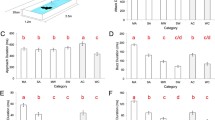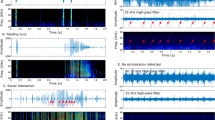Abstract
When searching for flying insects, Molossops temminckii uses unusual echolocation calls characterized by upward modulation of frequency vs time (UFM). Call frequency increases asymptotically in the relatively long (∼8 ms) pulses from a starting frequency of ∼40 kHz to a long narrowband tail at ∼50 kHz. When approaching a prey, the bat progressively increases the duration of calls and intersperses in the sequence broadband downwardly frequency-modulated signals with a terminal frequency of about 53 kHz, which totally replaces the UFM signals at the end of the approach phase. The sequence progresses to a capture buzz resembling those from other molossid and vespertilionid bats. The M. temminckii wing morphology is characterized by an average aspect ratio and a high wing loading, suggesting that it is more maneuverable than the typical Molossidae but less than typical Vespertilionidae. M. temminckii regularly forages near clutter, where it needs to pay attention to the background and might face forward and backward masking of signals. We hypothesize that the UFM echolocation signals of M. temminckii represent an adaptation to foraging near background clutter in a not very maneuverable bat needing a broad attention window. The broadband component of the signal might serve for the perception of the background and the narrowband tail for detection and perhaps classification of prey. Bats may solve the signal masking problems by separating emission and echoes in the frequency domain. The echolocation behavior of M. temminckii may shed light on the evolution of the narrowband frequency analysis echolocation systems adopted by some bats foraging within clutter.





Similar content being viewed by others
References
Altes RA, Titlebaum EL (1970) Bat signals as Doppler-tolerant waveforms. J Acoust Soc Am 48:1014–1020
Anderson S (1997) Mammals of Bolivia, taxonomy and distribution. Bull Am Mus Nat Hist 231:1–652
Anthony ELP (1988) Age determination in bats. In: Kunz TH (ed) Ecological and behavioral methods for the study of bats. Smithsonian Institution, Washington, D.C., pp 47–58
Barclay RMR, Brigham RM (1991) Prey detection, dietary niche breadth, and body size in bats: why are aerial insectivorous bats so small? Am Nat 137(5):693–703
Castroviejo S, López G (1974) Estudio y descripción de las comunidades vegetales de el Hato El Frío, en los Llanos de Venezuela. Mem Soc Cienc Nat La Salle 124:79–151
Denzinger A, Siemers BM, Schaub A, Schnitzler H-U (2001) Echolocation by the barbastelle bat, Barbastella barbastellus. J Comp Physiol A 187:521–528
Fenton MB, Audet D, Obrist MK, Rydell J (1995) Signal strength, timing, and self-deafening: the evolution of the echolocation in bats. Paleobiology 21:229–242
Fenton MB, Arita H, Rautenbach IL, Rydell J, Ortega J, Bouchard S, Hovorka MD, Lim B, Odgren E, Portfors C, Scully B, Syme D, Vonhof MJ (1998) Emergence, echolocation, diet and foraging behavior of Molossus ater (Chiroptera: Molossidae). Biotropica 30:314–320
Freeman PW (1981) A multivariate analysis of the family Molossidae (Mammalia, Chiroptera): morphology, ecology, evolution. Fieldiana Zool New Ser 7:1–173
Griffin DR (1958) Listening in the dark. Yale University Press, New Haven
Griffin DR, Webster FA, Michael CR (1960) The echolocation of flying insects by bats. Anim Behav 8:3–4
Hartley DJ (1989) The effect of atmospheric sound absorption on signal bandwidth and energy and some consequences for bat echolocation. J Acoust Soc Am 85(3):1338–1347
Heller KG (1995) Echolocation and body size in insectivorous bats: the case of the giant naked bat Cheiromeles torquatus (Molossidae). Le Rhinolophe 11:27–38
Holderied MW, Helversen Ov (2003) Echolocation range and wingbeat period match in aerial-hawking bats. Proc R Soc Lond B 270:2293–2299
Hoofer SR, Van Den Bussche RA (2003) Molecular phylogenetics of the chiropteran family Vespertilionidae. Acta Chiropterol 5:1–63
Houston RD, Boonman AM, Jones G (2004) Do echolocation signal parameters restrict bats’ choice of prey? In: Thomas JA, Moss CF, Vater M (eds) Echolocation in bats and dolphins. University of Chicago Press, Chicago, pp 339–345
Ibánez C (1984) Biología y ecología de los murciélagos del Hato El Frío, Apure, Venezuela. Doñana Acta Vertebr 8:1–271
Ibáñez C, Ochoa JG (1985) Distribución y taxonomía de Molossops temminckii (Chiroptera, Molossidae) en Venezuela. Doñana Acta Vertebr 12:141–150
Jensen ME, Miller LA (1999) Echolocating signals of the bat Eptesicus serotinus recorded using a vertical microphone array: effect of flight altitude on searching signals. Behav Ecol Sociobiol 47:60–69
Jones G (1994) Scaling of wingbeat and echolocation pulse emission rates in bats: why are aerial insectivorous bats so small? Funct Ecol 8:450–457
Jones G (1999) Scaling of echolocation call parameters in bats. J Exp Biol 202:3359–3367
Kalko EV (1995) Echolocation signal design, foraging habitats and guild structure in six neotropical sheath-tailed bats (Emballonuridae). In: Racey PA, Swift S (eds) Recent advances in bat biology, vol 67. Oxford University Press, London, pp 259–273
Kalko EKV, Schnitzler H-U (1993) Plasticity in echolocation signals of European pipistrelle bats in search flight: implications for habitat use and prey detection. Behav Ecol Sociobiol 33:415–428
Kalko EKV, Schnitzler H-U (1998) How echolocating bats approach and adquire food. In: Kunz TH, Racey PA (eds) Bat biology and conservation. Smithsonian Institution, Washington, D.C., pp 197–204
Kingston T, Jones G, Zubaid A, Kunz TH (2000) Social calls in clear-winged woolly bats (Kerivoula pellucida) from Malaysia. Bioacoustics 11:1–16
Kingston T, Jones G, Akbar Z, Kunz TH (2003) Alternation of echolocation calls in 5 species of aerial-feeding insectivorous bats from Malaysia. J Mammal 84:205–215
Kössl M, Mora EC, Coro F, Vater M (1999) Two-toned echolocation calls from Molossus molossus in Cuba. J Mammal 80:929–932
Marques JT, Rainho A, Carapuço M, OLiveira P, Palmeirim JM (2004) Foraging behaviour and habitat use by the European free-tailed bat Tadarida teniotis. Acta Chiropterol 6:99–110
Mora EC, Macías S, Vater M, Coro F, Kössl M (2004) Specializations for aerial hawking in the echolocation system of Molossus molossus (Molossidae, Chiroptera). J Comp Physiol A 190:561–574
Neuweiler G (1983) Echolocation and adaptivity to ecological constraints. In: Huber F, Markl H (eds) Neuroethology and behavioral physiology. Springer, Berlin Heidelberg New York, pp 280–302
Neuweiler G (1984) Foraging, echolocation and audition in bats. Naturwissenschaften 71:446–455
Neuweiler G (1989) Foraging ecology and audition in echolocating bats. Trends Ecol Evol 4:160–166
Neuweiler G (2000) The biology of bats. Oxford University Press, Oxford
Neuweiler G, Singh S, Sripathi K (1984) Audiograms of a South Indian bat community. J Comp Physiol A 154:133–142
Norberg UM (1994) Wing design, flight performance, and habitat use in bats. In: Wainwright PC, Reilly SM (eds) Ecological morphology: integrative organismal biology. Chicago University Press, Chicago, pp 205–239
Norberg UM, Rayner JMV (1987) Ecological morphology and flight in bats (Mammalia; Chiroptera): wing adaptations, flight performance, foraging strategy and echolocation. Philos Trans R Soc Lond B 316:335–427
Parsons S, Boonman AM, Obrist MK (2000) Advantages and disadvantages of techniques for transforming and analyzing chiropteran echolocation calls. J Mammal 81:927–938
Peters SL, Lim BK, Engstrom MD (2002) Systematics of dog-faced bats (Cynomops) based on molecular and morphometric data. J Mammal 83(4):1097–1110
Roverud RC (1987) The processing of echolocation sound elements in bats: a behavioural approach. In: Fenton MB, Racey P, Rayner JMV (eds) Recent advances in the study of bats. Cambridge University Press, Cambridge, pp 152–169
Roverud RC, Nitsche V, Neuweiler G (1991) Discrimination of wingbeat motion by bats, correlated with echolocation sound pattern. J Comp Physiol A 168:259–263
Schnitzler H-U, Kalko EKV (1998) How echolocating bats search and find food. In: Kunz TH, Racey PA (eds) Bat biology and conservation. Smithsonian Institution, Washington, D.C., pp 183–196
Schnitzler H-U, Moss CF, Denzinger A (2003) From spatial orientation to food acquisition in echolocating bats. Trends Ecol Evol 18:386–394
Schnitzler H-U, Kalko EKV, Denzinger A (2004) Evolution of echolocation and foraging behavior in bats. In: Thomas JA, Moss CF, Vater M (eds) Echolocation in bats and dolphins. The University of Chicago Press, Chicago, pp 331–339
Siemers BM, Schnitzler H-U (2004) Echolocation signals reflect niche differentiation in five sympatric congeneric bat species. Nature 429:657–661
Siemers BM, Kalko EKV, Schnitzler H-U (2001) Echolocation behavior and signal plasticity in the neotropical bat Myotis nigricans (Schinz, 1821) (Vespertilionidae): a convergent case with European species of Pipistrellus? Behav Ecol Sociobiol 50:317–328
Sierro A, Arlettaz R (1997) Barbastelle bats (Barbastella sp.) specialize in the predation of moths: implications for foraging tactics and conservation. Acta Oecologica 18:91–106
Simmons NB (2005) Order Chiroptera. In: Wilson DE, Reeder DM (eds) Mammal species of the world. A taxonomic and geographic reference, 3rd edn, vol 1. The Johns Hopkins University Press, Baltimore, pp 312–529
Simmons JA, Grinnell AD (1988) The performance of echolocation: acoustic images perceived by echolocating bats. In: Nachtigall PE, Moore PWB (eds) Animal sonar. Plenum, pp 353–385
Simmons JA, Lavender WA, Lavender RA, Childs JE, Hulebak K, Rigden MR, Sherman J, Woolman B (1978) Echolocation by free-tailed bats (Tadarida). J Comp Physiol A 125:291–299
Smith JD, Starrett A (1979) Morphometric analysis of chiropteran wings. In: Baker RJ, Jones JKJ, Carter DC (eds) Biology of the bats of the new world family phyllostomatidae, Part III, vol 16. Texas Tech University, Lubbock, pp 1–441
Sotavalta O (1947) The flight tone (wing-stroke frequency) of insects. Acta Entomol Fennica 4–5(4):1–117
Sum YW, Menne D (1988) Discrimination of fluttering targets by the FM-bat Pipistrellus stenopterus? J Comp Physiol A 163:349–354
Tian B, Schnitzler H-U (1997) Echolocation signals of the greater horseshoe bat (Rhinolophus ferrumequinum) in transfer flight and during landing. J Acoust Soc Am 101:2347–2364
Vater M, Siefer W (1995) The cochlea of Tadarida brasiliensis: specialized functional organization in a generalized bat. Hear Res 91:178–195
Willig MR (1985) Ecology, reproductive biology and systematics of Neoplatymops mattogrossensis (Chiroptera: Molossidae). J Mammal 66:618–628
Zbinden K, Zingg PE (1986) Search and hunting signals of echolocating european free-tailed bats, Tadarida teniotis, in southern Switzerland. Mammalia 50(1):9–25
Acknowledgment
We are most grateful to Carlos Ruiz Benavides, Ariany García, and Esquisa Omaña for their help during field work in Venezuela. The staff at the El Frío Biological Station, particularly Rafael Antelo, Juanma and Julio, provided invaluable logistic support for the field work. The Maldonado family, owner of the ranch “Hato El Frío,” has enforced a reconciled management of the land. This allows the conservation of the natural habitats and the persistence of the rich wildlife that we have been studying. Funding for travel and fieldwork in 2006 was provided by grant no. 39709 from the Mexican National Council for Science and Technology (CONACyT). The research reported here complied with the current laws of the Republic of Venezuela. Michael Smotherman, Winston C. Lancaster, and two anonymous referees made fundamental critical comments on earlier versions of this paper. Charles M. Francis and Leonel Torres helped us in revising the language.
Author information
Authors and Affiliations
Corresponding author
Additional information
Communicated by G. Jones
Rights and permissions
About this article
Cite this article
Guillén-Servent, A., Ibáñez, C. Unusual echolocation behavior in a small molossid bat, Molossops temminckii, that forages near background clutter. Behav Ecol Sociobiol 61, 1599–1613 (2007). https://doi.org/10.1007/s00265-007-0392-4
Received:
Revised:
Accepted:
Published:
Issue Date:
DOI: https://doi.org/10.1007/s00265-007-0392-4




